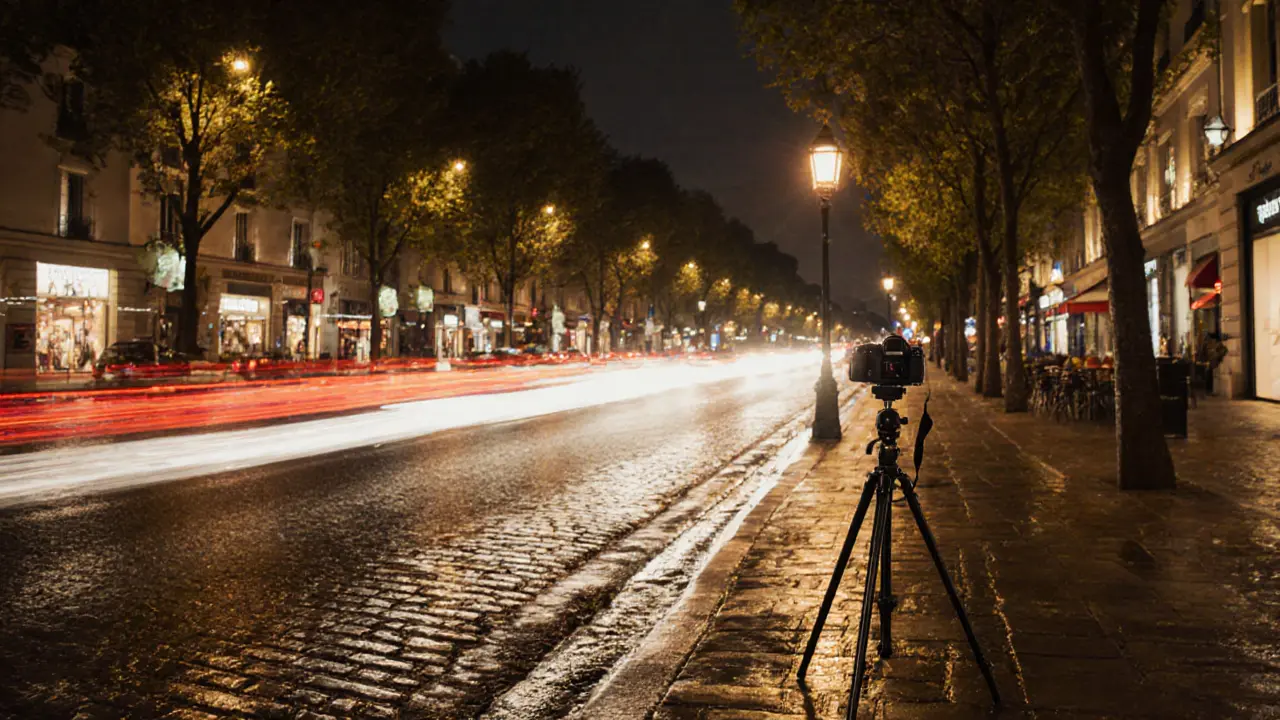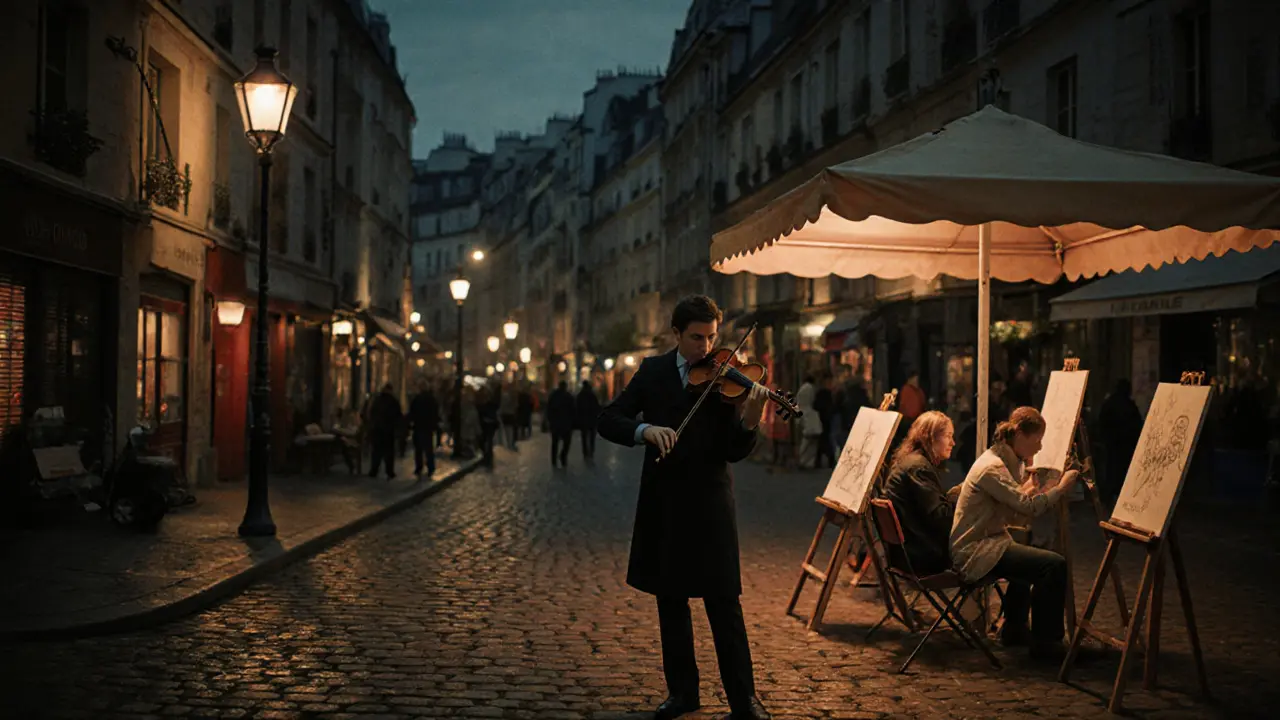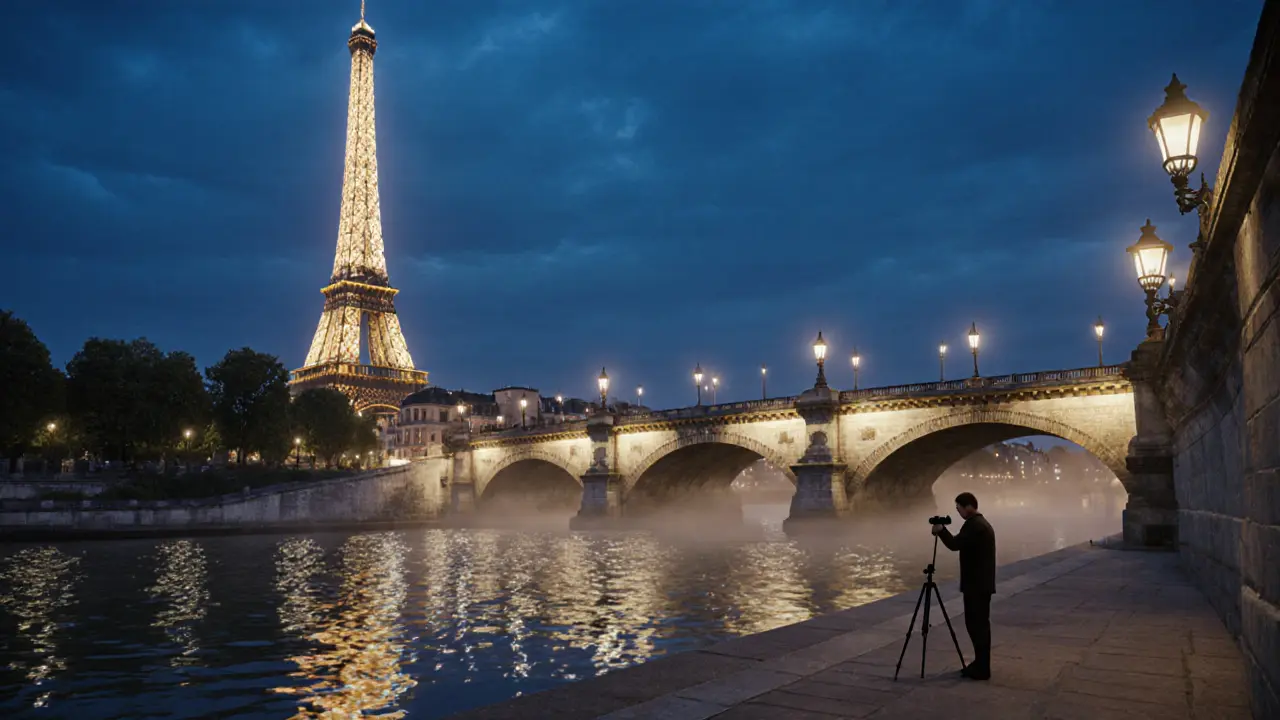You’ve seen the photos. The Eiffel Tower sparkling at midnight. The Seine reflecting golden streetlights. A lone violinist under a bridge, haloed by soft lamplight. You want that shot. Not just any shot - the shot. The one that makes people stop scrolling and say, ‘Wow, I need to go there.’ But here’s the truth: your phone won’t cut it. And your auto mode? That’s not photography. That’s luck.
Paris at night isn’t just a place. It’s a mood. A rhythm. A dance of light and shadow that changes every hour. To capture it, you need more than a camera. You need to understand how light behaves when the city turns quiet. How the glow from café signs lingers longer than you think. How the sparkle of the Eiffel Tower isn’t constant - it blinks every 60 seconds, and only for five minutes. Miss that window, and you miss the magic.
Why Night Photography in Paris Is Different
Daytime Paris is crowded. Nighttime Paris is alive - but in a quieter, more intentional way. The crowds thin. The noise fades. But the light? It multiplies. Streetlamps, shop windows, neon signs, moving cars, and the Eiffel Tower’s sparkling sequence all compete for attention. Your camera has to choose what to highlight. And if you’re shooting in auto, it’ll pick wrong.
Most tourists think they need a fancy DSLR. You don’t. But you do need to understand three things: aperture, shutter speed, and ISO. These aren’t technical jargon. They’re your three tools to control light. Think of them like a trio of knobs on a radio. Turn one too far, and the whole song breaks.
Camera Settings That Actually Work in Paris at Night
Here’s what works - tested on the streets of Montmartre, along the Seine, and in front of Notre-Dame. These aren’t guesses. These are settings used by professional travel photographers who shoot Paris every month.
- Aperture: f/2.8 to f/4 - Wide enough to let in light, but not so wide that everything goes blurry. f/2.8 is perfect for portraits with soft background bokeh. f/4 is better for wide shots of streets or bridges.
- Shutter Speed: 1/15s to 8s - Slow shutter = more light. But slow also means motion blur. If you’re shooting a moving car’s light trail, go for 4-8 seconds. For static scenes like the Eiffel Tower, stick to 1-2 seconds. Use a tripod. Always.
- ISO: 800-3200 - Don’t be afraid of noise. Modern cameras handle high ISO better than ever. ISO 1600 is your sweet spot. Go higher only if you’re in deep shadow and need to freeze motion.
- Focus: Manual Focus on a Bright Light - Autofocus fails in low light. Point your lens at a streetlamp, half-press to lock focus, then recompose. Or switch to manual and use your camera’s focus peaking feature.
- White Balance: 3200K-4000K - Too warm, and the city looks like a movie set. Too cool, and it looks sterile. 3800K gives you that classic Parisian golden glow without looking fake.
Pro tip: Shoot in RAW. Not JPEG. RAW files save every bit of light data. You can fix exposure, color, and shadows later. JPEG? That’s a one-shot deal. If you mess up, you’re stuck.
Best Lenses for Night Photography in Paris
You don’t need ten lenses. You need one or two that do the job.
- 35mm f/1.8 - The most versatile. Fits whole streets, cafés, and bridges without distortion. Great for storytelling shots.
- 50mm f/1.8 - The classic ‘nifty fifty.’ Perfect for portraits of musicians, couples under lights, or close-ups of wine glasses at a bistro. Super sharp, cheap, and lightweight.
- 24mm f/2.8 - If you want to capture the full width of the Champs-Élysées or the arc of the Pont Alexandre III. Great for wide-angle drama.
Avoid zoom lenses like 18-200mm. They’re slow. They’re heavy. And at f/5.6 or worse, they’ll let in too little light. You’ll end up with grainy, blurry shots. Stick to primes. They’re lighter, faster, and make your photos look professional.
Where to Shoot: Best Spots for Night Photos in Paris
Not every corner of Paris lights up beautifully. Here are the five spots that deliver every time.
- Pont Alexandre III - The most ornate bridge in Paris. At night, the gaslamp-style lights reflect perfectly in the Seine. Shoot from the riverbank on the Left Bank for symmetry.
- Place du Tertre, Montmartre - Artists, musicians, and dim lanterns. The cobblestones catch light like a mirror. Shoot after 9 PM when the crowds thin.
- Champ de Mars, near Eiffel Tower - The classic view. But here’s the trick: walk 500 meters south to the footbridge over Rue de la Tour. You’ll get the tower with the Seine in the foreground. Less crowded. More cinematic.
- Canal Saint-Martin - Moody, quiet, and full of character. The water reflects café lights and passing boats. Shoot at 11 PM when the last lights turn on.
- Notre-Dame Square (outside the cathedral) - The gothic arches glow under spotlights. The stone texture looks like it’s breathing. Use a wide lens and shoot just after sunset when the sky is still blue.
Pro tip: Use Google Maps in offline mode. Download the area before you go. No signal? No problem. You’ll still know where to walk.

What to Bring: Beyond the Camera
Paris at night is beautiful. But it’s also chilly. And crowded. And sometimes, unsafe if you’re distracted.
- Compact tripod - A phone tripod won’t cut it. Get a carbon fiber one that folds to the size of a water bottle. The Joby GorillaPod is a favorite.
- Extra batteries - Cold drains batteries fast. Bring two. Charge them before you leave your hotel.
- Small flashlight - Not for lighting your shot. For finding your lens cap, checking your settings, or walking back to your hotel.
- Lightweight jacket - Even in summer, the river breeze drops the temperature by 10°C after dark.
- Memory cards with 64GB+ capacity - RAW files eat space. Don’t risk running out.
What to Avoid
Here’s what ruins night photos in Paris - and how to dodge it.
- Using flash - It kills the atmosphere. No one wants a bright white face in front of the Eiffel Tower.
- Shooting during the Eiffel Tower sparkle - Everyone’s doing it. The crowd is huge. The light is too bright. Wait until the sparkle ends. Shoot the tower in its normal glow. It’s more powerful.
- Ignoring the weather - Rain makes Paris magical. Wet streets reflect lights like glass. But your gear doesn’t like water. Use a rain cover or a plastic bag with a hole for the lens.
- Walking alone with expensive gear - Stick to well-lit, populated areas. Montmartre at 2 AM? Not worth it. Stick to the Seine, the Marais, or the 7th arrondissement.
Paris Night Photography vs. Daytime Photography
| Factor | Night Photography | Daytime Photography |
|---|---|---|
| Light Source | Artificial (lamps, signs, tower) | Natural (sun) |
| Best Aperture | f/2.8-f/4 | f/8-f/11 |
| Shutter Speed | 1/15s to 8s | 1/500s to 1/1000s |
| ISO Range | 800-3200 | 100-400 |
| Crowds | Thinner after 9 PM | Heavy, especially at landmarks |
| Best Lens | 35mm or 50mm prime | 24-70mm zoom |
| Post-Processing | Essential - fix shadows, noise | Optional - mostly color correction |

What to Expect When You’re Shooting
You’ll walk for miles. Your feet will ache. Your fingers will go numb. You’ll miss the last metro twice. But then - you’ll see it. The Eiffel Tower glowing under a clear sky. A couple sharing a crepe under a lantern. A cat curled up on a windowsill, bathed in amber light. That’s when you realize: this is why you came.
Paris at night doesn’t shout. It whispers. And your camera? It’s the only thing that can hear it.
How to Book a Night Photography Tour (If You’re New)
If you’ve never shot at night, a guided tour is worth it. You’ll learn where to go, when to be there, and how to use your camera without stress.
- Paris Night Photography Tour by Paris Photo Walks - 3 hours, max 8 people. Guides are professional photographers. Includes a free RAW file editing tutorial. €65 per person.
- Seine River Night Photo Cruise - 2 hours on a small boat. Shoot the tower, bridges, and lights from the water. Includes hot tea and snacks. €85 per person.
Book ahead. These tours sell out, especially in spring and fall.
Frequently Asked Questions
Can I use my smartphone to photograph Paris at night?
Yes - but with limits. Modern phones like the iPhone 15 Pro or Google Pixel 8 have night modes that work well for static scenes. But they can’t capture motion blur, long exposures, or shallow depth of field like a real camera. For the Eiffel Tower sparkle or light trails from cars, you’ll need a tripod and manual controls. Most phone apps don’t let you adjust ISO or shutter speed properly. If you’re serious, bring a camera.
Is it safe to take photos in Paris at night?
Most areas are fine if you’re smart. Stick to well-lit, tourist-friendly zones: the Seine, Montmartre (before midnight), the Marais, and the Champs-Élysées. Avoid empty alleys, especially near Gare du Nord or in the 18th arrondissement after 11 PM. Keep your camera close. Don’t flash expensive gear around. Pickpockets target distracted photographers. Trust your gut - if a place feels off, leave.
When does the Eiffel Tower sparkle?
Every hour, on the hour, for five minutes, starting at sunset until 1 AM. The sparkle is made of 20,000 LED lights that flash in sequence. The best time to shoot it is right after the sparkle ends - when the tower is still lit but the crowds have thinned. If you wait until the sparkle, you’ll get a blurry mess from too many phones.
Do I need a tripod for Paris night photos?
Absolutely. Even if your camera has image stabilization, you need a tripod for exposures longer than 1/15s. Handheld shots at night will be blurry. A small, lightweight tripod like the Joby GorillaPod or Manfrotto BeFree is easy to carry and fits in a backpack. Don’t skip it.
What’s the best time to shoot Paris at night?
The hour after sunset - called the blue hour - is magic. The sky is still dark blue, but the city lights are fully on. It lasts about 30-45 minutes. After that, the sky turns black, and the lights dominate. For the Eiffel Tower, shoot right after the sparkle ends. For quiet streets, go after 10 PM when the last tourists leave.
Ready to Capture Paris at Night?
Don’t just visit Paris. Record it. The city doesn’t stay the same for long. The lights change. The seasons shift. The people come and go. But your photos? They’ll last forever. Grab your camera. Charge your batteries. Walk out after dark. And let Paris show you what it really looks like when the world sleeps.




